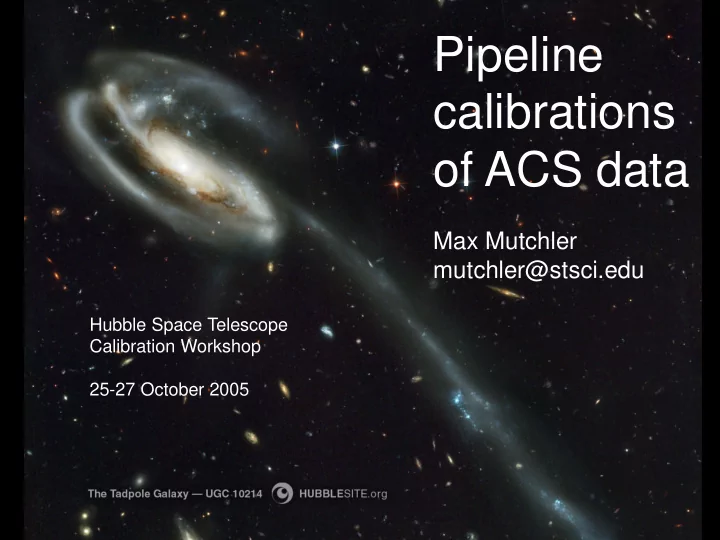

Pipeline calibrations of ACS data Max Mutchler mutchler@stsci.edu Hubble Space Telescope Calibration Workshop 25-27 October 2005
ACS pipeline processing
Acknowledgements and References • ACS bias and dark calibration cohorts: Marco Sirianni, Ray Lucas (see posters) • Reference file production and delivery: Mike Swam, Rossy Diaz-Miller • CALACS+MultiDrizzle pipeline: Anton Koekemoer, Warren Hack, Chris Hanley • ACS reference file webpages: http://www.stsci.edu/hst/acs/analysis/reference_files
Pipeline drizzling • MultiDrizzle in the pipeline; uses a parameter table (MDRIZTAB) • POS TARGs now also automatically associated (and drizzle-combined) • Filter-dependent distortion solutions (polynomial) with residual correction (image) • More in Anton’s talk / splinter session…
Philosophy and Practices • “Best” calibration reference files typically available within 2-3 weeks after any observation: quality vs timeliness • Automated reference file production • Production in native pipeline environment (SunFire) • Consolidated deliveries to CDBS & archive • Reference file quality control, and CCD trending
WFC and HRC bias calibration • Bias level is measured from each frame’s overscan (with some random variation!), and subtracted (by amplifier quadrant) • Bias features are subtracted by the “superbias” reference file (BIASFILE) • Bi-weekly superbias is a simple cleaned combination of 8 frames taken during each two-week period • Bias structure (mainly bad columns) assigned flag 128 in each superbias data quality (DQ) array as of Oct 2004; was in a static bad pixel table (BPIXTAB); flags propagate to science data
WFC and HRC bias features
Bias structure and corresponding flagging (as of Oct 2004) WFC bad columns DQ flag 128
WFC and HRC dark calibration • Monthly CCD annealing • Four 1000-second dark frames now obtained every other day (was every day until Oct 2004), and just before/after each CCD annealing • Superdark (DARKFILE) is a hybrid combination of a 2- week “basedark” (has less noise) and a 4-frame “daydark” (has daily warm and hot pixels) • Residual bias level correction, so superdarks don’t propagate one source of this problem • Dark features (not just hot pixels anymore) flagged in superdark data quality (DQ) array. More later…
WFC and HRC dark features
ACS / WFC dark current histogram 2002-2005 warm pixels 2005 hot pixels 2002
Superdark reference files are hybrids, made from a 2-week “basedark”, with warm and hot pixels from a 4-frame “daydark” added
Make-your-own “hyperdarks” – the UDF
WFC superdark and corresponding data quality flagging SCI array DQ array
New ACS data quality flagging • Starting Oct 2004, we redefined some redundant DQ flags for new use in reference file DQ arrays • Use ref file DQ arrays more, use bad pixel table (BPIXTAB) less • Flag 128 now used in superbias DQ (better trending) • Flag 32 redefined as “hot pixel CTE tails” (just the first trailing pixel for now) in superdark DQ • Flag 64 redefined as “warm pixels” between 0.02 and 0.08 e/sec (also gets more of the CTE tails) in superdark DQ • New flags provide optional leverage: the pipeline ignores flags 32 and 64 • Must set bits=96 to ignore new flags in standalone drizzling, or leave bits=0 to exclude these pixels
Some unexpected anomalies • Random bias level variations: correcting it in superdarks (at least) • Scattered light in dark frames: cross filters after annealing • Amplifier crosstalk (inverse ghosts): gain=2 minimizes it
Correcting random bias offsets in superdarks (so they don’t propagate to your science data) Before After
Amplifier crosstalk
Max’s wishlist • Two eras: make new flagging scheme retroactive. Monthly bad pixel tables for 2002-2004? • More complete flagging of hot pixel CTE tails • Data associated more completely for MultiDrizzle. Ingest asn tables for data already in the archive? • Add image registration (e.g. tweakshifts) to pipeline. Ingest asn tables with shifts included? • Better handling of moving target (planetary) observations in the pipeline: non-WCS image combination, single-image output
Recommend
More recommend